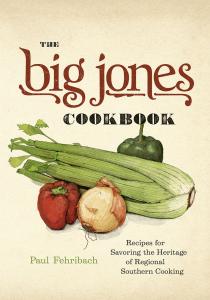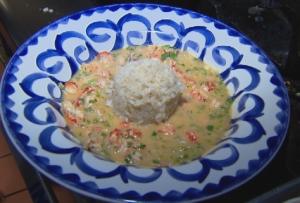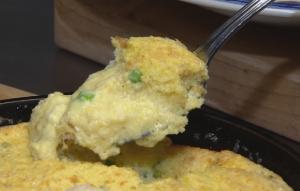James Beard semifinalist Paul Fehribach, executive chef of Andersonville's Big Jones restaurant, joins Chicago Tonight to discuss the recipes and history in his new Southern cookbook.
In this web extra video, Fehribach cooks Awendaw Spoonbread and Crawfish Étouffée.
Crawfish Étouffée
Étouffée is another perfect example of a distinctively regional Southern dish that is often subjected to the preconceived notions of authenticity that develop when folks have a limited experience with one regional variation. With etouffée, it’s most likely to be an exposure to the New Orleans Creolized versions that are very often roux-based and tomato-heavy. In Cajun country, where crawfish etouffée originated, it often has no roux and might consist of nothing but butter, wine, onions, and maybe a few spices. Interestingly, early Creole recipes for smothered fish or shellfish more closely resembles this Cajun recipe than current Creole versions.
Legend (or facts, if you choose to believe the highly credible story) has it that the term etouffée, which means “smothered” in Arcadian French, was first assigned to a dish of crawfish smothered in butter and wine in the late 1920s at the Herbert Inn in Breaux Bridge, when a French-speaking guest wandered into the kitchen and inquired what was cooking for dinner. In full French-speaking mode, the Herbert sister who was cooking replied simply that she was smothering crawfish, which came out as etouffée. Variations of this basic preparation exist from the 1790s in the Creole cooking of the region, more commonly using shrimp than crawfish. Talk about blurring the lines between Cajun and Creole!
Until the 1920s and ‘30s, crawfish were considered lowly laborer food and were still associated more with slave or sharecropper cooking than proper white folks’ food. By the late 1930s and ‘40s, more Cajuns started to “come out” as crawfish eaters, and south Louisiana cooking has never looked back.
PREP TIME: 30 minutes
EQUIPMENT NEEDED: 10-inch cast-iron skillet, long-handled wooden spoon
SERVES: 4-6
1/2 cup (1 stick) plus 2 tablespoons (1/4 stick) cold unsalted butter, cut into 1/2-inch-thick pats and divided
1/2 cup yellow onion, finely diced
1/4 cup green bell pepper, finely diced
1/4 cup celery, finely diced
3 cloves garlic, mashed and minced
1/2 cup dry, fruity white wine
1 nice-size sprig of thyme
1 pound of picked crawfish tails, with fat and juice
1/2 teaspoon cayenne pepper, or to taste
1 to 2 tablespoons of kosher salt, or to taste
2 tablespoons freshly squeezed lemon juice
2 tablespoons Worcestershire sauce
1/4 cup parsley, finely choppedIn a 10-inch cast-iron skillet over medium-high heat, melt 2 tablespoons butter until foaming but not brown. Add the onion, bell pepper, celery, and garlic all at once, and stir constantly while cooking until they sweat and turn translucent and soft but not brown, 2 to 3 minutes. Add the white wine and thyme, and bring to a boil while stirring regularly with a wooden spoon. Maintaining a brisk boil, reduce the wine by half, 2 to 3 minutes. Add the crawfish, pepper, and some of the salt, and return to a boil, stirring often. The crawfish will render some additional juice—continue at a brisk boil for 2 minutes to reduce until only 1/4 inch of liquid remains in the bottom of the skillet.
Reduce heat to medium, and stir in the remaining 1/2 cup of butter, stirring constantly until all is melted and steaming hot. Remove from heat immediately once the butter has all melted and you see steam rising from the skillet. Do not boil or the sauce will break! Remove the thyme sprig, and season with lemon juice, Worcestershire, and parsley, plus additional salt and pepper as desired. Serve it up at once with hot steamed rice.
Awendaw Spoonbread
One of the museum pieces of Southern food lore, spoonbread dates to the earliest days of the European settlement and is immortalized in Sarah Rutledge’s The Carolina Housewife (1847) under the name “Owendaw Bread.” By the twentieth century, it was particularly popular in Appalachia and has a storied history in Kentucky, appearing in many of that state’s great cookbooks and garnishing the reputations of some of its finest inns.
There’s more than one way to give the savory pudding-like texture to your spoonbread, the most popular being to change the ratios of cornmeal, buttermilk, and eggs to simply make a softer bread. The less common, and we believe best way per Sarah Rutledge’s receipt, is the ancient method of combining creamy cooked grits (likely samp in the earliest days) with your cornmeal and milk to make the batter. Ours is lightened ever so lightly with the addition of a touch of baking powder—not a totally authentic spoonbread, but I love the soufflé-like texture you get as a result.
A great spoonbread is light as a soufflé yet rich as the most splendid savory pudding. Even on its own, this can make a light meal with a small salad, but it’s great for breakfast, lunch, or dinner, and goes with everything.
PREP TIME: 2 hours
EQUIPMENT NEEDED: 2-quart cast-iron or enamel casserole, 1-quart saucepan, wire whisk, wire mesh skimmer or slotted spoon, 4-quart mixing bowl
SERVES: 4 to 6
1 3/4 cups whole milk
1/2 teaspoon cayenne pepper
2 teaspoons kosher salt
1/2 cup stone-ground hominy grits
1/2 cup (1 stick) unsalted butter, cut into bits
1/2 cup sharp cheddar cheese, shredded
4 large eggs
1 1/2 cups lowfat buttermilk
1/3 cup stone-ground fine cornmeal
1 teaspoon baking powder
1/2 cup sliced green onion, optional
1 cup crackling optional (page 264)Preheat oven to 350 °F. Thoroughly butter a heavy 2-quart cast-iron or enamel casserole.
Place milk, cayenne, and salt in a 1-quart saucepan over medium-high heat, and bring to a boil, whisking occasionally to prevent scorching. Sprinkle the grits into the hot milk and whisk in. Pause, allowing the germ and chaff to rise to the top. Use a skimmer or slotted spoon to skim it off. Resume whisking and continue until the milk thickens measurably, about 3 to 5 minutes. Reduce heat to a low boil and continue whisking regularly to prevent sticking and scorching. The grits will take about 40 minutes to cook: They are done when larger grits have a nice bite to them but no hard starchy center, and the overall mixture is heavy and creamy. Whisk in the butter and cheese until fully incorporated and creamy. Remove from heat and proceed immediately to the batter.
In a 4-quart mixing bowl, whisk the eggs until frothy, then beat in the buttermilk. Combine the cornmeal and baking powder in a small dish, and then sprinkle over the buttermilk and whisk in. Whisking constantly, slowly pour the hot grits into the buttermilk and beat until smooth. Add the optional green onion and crackling, and pour batter into the buttered casserole. Bake on the top rack of the oven until light and fluffy, yet set in the center and nicely browned, about 50 to 60 minutes. You’ll know when it’s done when the spoonbread jiggles as a whole mass when gently shaken. If it makes liquid waves in the center, it needs more time. Top with butter and serve with jam or sorghum molasses.
From The Big Jones Cookbook, by Paul Fehribach. Copyright 2015 by Paul Fehribach. Published by the University of Chicago Press. All rights reserved.
Big Jones was featured on WTTW’s Check, Please! Watch the episode.






